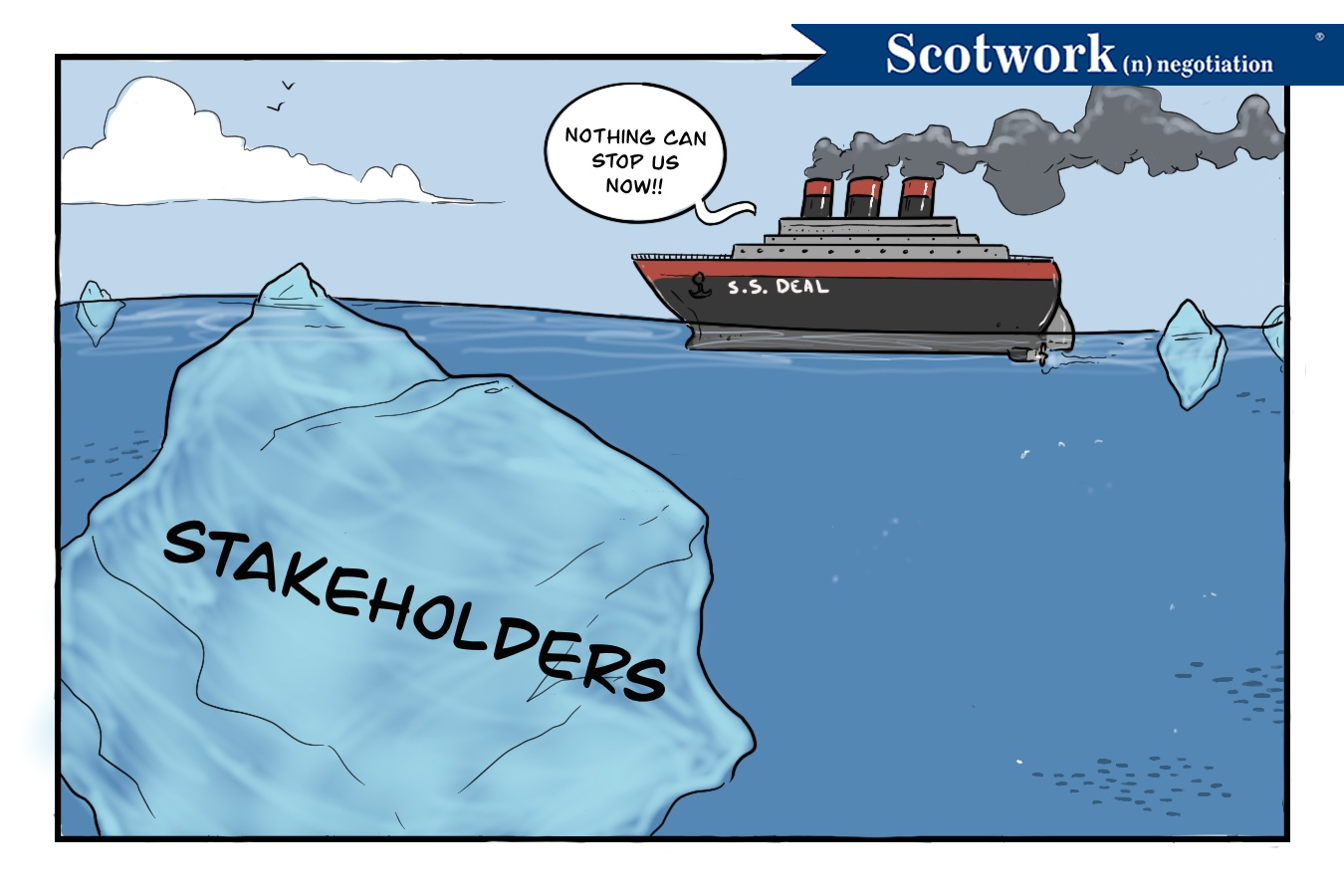This past week, a rare news headline appeared out of Washington, D.C.: “A Deal With Bipartisan Support.” Before you run off, this post is not a political commentary. Rather, the headline got me thinking about how we create internal alignment in business. After all, gaining internal alignment in negotiations is a very common challenge. Most people don’t do it effectively, and lack of alignment can become an iceberg that sinks a deal. Surely, if politicians can figure out alignment occasionally, then we in business can do it with much greater frequency and success.
On Amazon.com, there are more than 30,000 books that discuss business relationships — including Dale Carnegie’s How to Win Friends & Influence People, published in 1936. Suffice it to say, the challenges of managing business relationships are nothing new. Carnegie wrote something that can hold the key to unlocking the internal alignment issue: “You can gain more influence by being interested in the other side for 10 minutes than by trying to get them interested in you for 10 months.”
Oftentimes, internal alignment breaks down because we rarely consider the needs of the other person beforehand. Instead, we either don’t take the other person into consideration to begin with or we just try to sell them on a deal after the fact. However, if you take Carnegie’s suggestion to heart, learning what’s important to the stakeholder before you finalize your plan and go into a negotiation, you’ll find dealing with stakeholders throughout the process much easier. It will also help you develop a strategy that takes the stakeholder’s position into account. It’s basic needs analysis done with an internal focus.
Once you’ve done the internal needs analysis, come back to each of your stakeholders to start the alignment process. This process is not about selling the deal at the end, but rather gaining support from the start. When you approach the stakeholder for support, here’s what you need to bring to the table:
- Define the problem. Tell them, specifically, what it is that you’re trying to negotiate. You may have already told them about the problem during your needs analysis, but don’t assume that they know the full picture. It’s important for all of your stakeholders to understand the negotiation at hand. So be clear, precise, and consistent with each of them.
- Tell them why the negotiation is important. Typically, your negotiation’s importance is self-evident. However, assume that others don’t understand the problem the way you do. Be sure to explain to the stakeholder why this negotiation’s outcome is important to the business as well as for them.
- Tell them your approach. With the groundwork for the negotiation (and its importance) having been laid, explain your plan for negotiating the outcome — and how the stakeholder’s needs fit into the equation. Give them a sense of your strategy and why their input will help you to accomplish the negotiation’s goals.
Once you’ve done that, then ask for a response to this question: If I take this approach and get this deal, will you support it?
You might as well find out sooner rather than later if your stakeholder supports the approach and the deal that you intend to get. If they say “yes,” great! From there, I would be asking for latitude around issues that may impact them. For instance, asking a question like, “Under what circumstances would you be comfortable with doing . . .?” This can help you gain more flexibility when you’re at the table. You can also ask, “Is there anything else you’d like for me to consider as I go into the negotiation?” These questions are geared toward the other person’s needs based on the negotiation’s strategy.
If they say “no,” find out why. It could be because you missed something in the needs analysis. It could also be that the stakeholder doesn’t have full authority to endorse the approach. Regardless, you’ll want to find out why, and then address those objections before you start the negotiation. That way, you don’t waste time after the fact, and you minimize the chance of potentially having to renegotiate the deal.
This process does take a little more effort up front, but it saves so much time on the back end of the deal while also ensuring that your deal is supported. Aligning your stakeholders during the planning process will allow you to avoid disappointment and longer internal negotiations once the deal is done. The other option is to ignore your stakeholders during the planning process. If you go that route, just beware of the looming iceberg that could very well sink your deal . . .
We Can Help You Create Internal Alignment Around Your Deals.
Have you ever finalized a negotiation strategy and gone to the table without first learning what’s important to your stakeholders? Then you know how a lack of internal alignment can lead to disappointment and longer internal negotiations once the deal is done. We can help! Drawing on 45 years of real-world negotiating experience, we’ll assist you with getting better deals, saving time, and creating value for all involved — not to mention preserving and even strengthening relationships. Let us partner you with one of our advisers, ensuring that you’ve got the broadest view of your deal.

